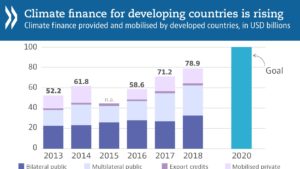Climate finance for developing countries rose to USD 78.9 billion in 2018

The increase was driven by a rise in public climate finance, while private climate finance was flat, according to new figures from the OECD.
Climate Finance Provided and Mobilised by Developed Countries in 2013-18 is the OECD’s third assessment of progress towards the UNFCCC goal of mobilising USD 100 billion per year by 2020 to help developing countries tackle and adapt to climate change. This latest report deepens the analysis of aggregate figures by providing more insights on the characteristics and recipients of climate finance over the period studied.
The report finds that public climate finance from developed countries reached USD 62.2 billion in 2018. Bilateral public climate finance accounted for USD 32.7 billion, up by 21% on 2017, and multilateral public climate finance attributed to developed countries accounted for USD 29.6 billion, up by 8% on 2017. The level of private climate finance mobilised was virtually flat, at USD 14.6 billion in 2018, after USD 14.5 billion in 2017. Climate-related export credits remained small at USD 2.1 billion, accounting for less than 3% of total climate finance.
“Climate finance to developing countries continues to grow but in 2018 was still USD 20 billion short of the 2020 goal of mobilising USD 100 billion. Early 2019 data from the European Union and its member states, the largest provider taken collectively, indicate that bilateral public climate finance may have continued to increase last year,” said OECD Secretary-General Angel Gurría. “Donors need to urgently step up their efforts to support developing countries to respond to the immediate effects of the pandemic and to integrate climate actions into each country’s recovery from the COVID-19 crisis to drive sustainable, resilient and inclusive economic growth.”
The report shows that out of the overall climate finance in 2018, 70% went to climate change mitigation activities, 21% went to adaptation and the remainder to crosscutting activities. More than half of total climate finance targeted economic infrastructure – mostly energy and transport – with most of the remainder going to agriculture and social infrastructure, notably water and sanitation.
Over 2016-18, Asia benefited from the largest share of climate finance at 43%, followed by Africa (25%) and the Americas (17%). In terms of distribution by income group, 69% of climate finance went to middle-income countries, 8% went to low-income countries and 2% went to high-income countries, with the remaining 21% allocated at regional rather than country level.
In terms of public finance instruments, both loans and grants increased in absolute terms. The share of loans, however continued to rise, reaching 74% of the USD 62.2 billion public finance figure in 2018, up from 52% in 2013, while the share of grants decreased from 27% to 20%. The share of grants was higher to low-income countries, at 42%, while the share of loans was higher in middle-income countries, at 88%.
Download a Summary of key findings: Climate Finance in 2013-18